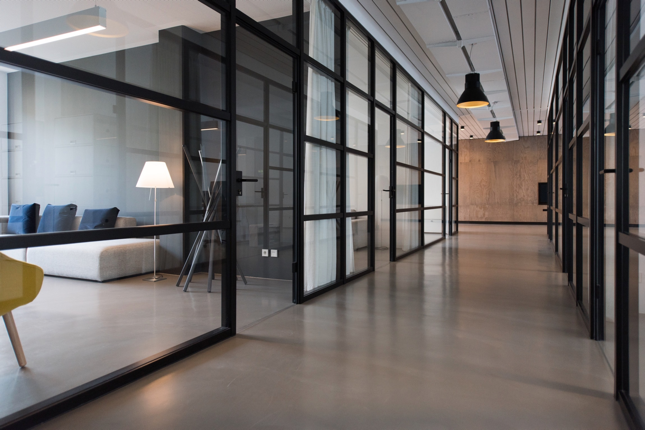Updated February 17, 2021
Class A office space can be the creme de la creme of commercial real estate, but only when the premium amenities that come with Class A office space are important to your organization’s goals. When reviewing your options, your tenant broker should be guiding you through a conversation to identify what those priorities are and how to best align your operations with your real estate. The purpose of this blog post is to not only educate you on what Class A office space is, but give you professional insights to consider before signing the dotted line.
Key Characteristics for Class A Property
Class A office space is an amenity rich environment that’s visually and structurally defined by high end building materials – such as concrete, glass, and steel with the intention of offering a luxury experience. Typically, these properties are centrally located, and either built or remodeled within the past decade.
Examples of these office amenities would include, but are not limited to:
- Onsite security
- Grand lobby entrance
- Manicured landscaping
- Convenient dining options
- State of the art fitness
- Conferencing centers
- Secured parking
While Class A office space does offer that “wow factor,” it’s important to consider all angles.
How to Find Commercial Office Space
First, I recommend working with your broker 12-18 months in advance of needing to relocate or consider a renegotiation. Take ample time to properly strategize and not rush into this decision. A simple question you can begin to ask yourself is, “Between location, quality, and price, which two mean the most to my organization?” Location should not only focus on its surroundings but assessing all possible commutes and how that impacts your employees. Quality pertains to its physical attributes such as exterior and interior finishes as well as the amenities mentioned above. Price meaning how much will your rents impact your bottom line in the long run and what can your organization withstand to afford. Class A office space is generally in favor of location and quality, while sacrificing price.
How much is Office Space?
Every Submarket is different, but to shed some light on what these differences can look like, Downtown San Diego average Class A office space is $3.14/SF/Mo, while Class B averages around $2.49/SF/Mo. For easy math, with a 10,000 SF space, that’s the difference of $6,500 per month, and $78,000 per year. An average term is 3-5 years, bringing a grand total difference of $234,000-$390,000 respectively for the term of the lease. To some, this is money well spent. To others, this could be the difference between success and failure.
Is Class A Office Space Right for You?
Now you have some direction, great! The initial identification of properties is only the very beginning of your journey. It’s in the negotiation phase where color is brought to the picture. Your broker should be helping you to identify what your relationship with the landlord is going to look like and position you as a sought-after tenant so that the business points favor you! There are amazing opportunities out there if you know where and how to look, as exemplified by the following stories of real situations that can help you clarify if Class A office space is right for you.
One of my clients was introduced to us with no time to do a proper search and only cared about being in Class A space – we had no choice but to execute at lightning speed or else they would have been paying holdover rents. They ended up in a short-term lease in a Class A building with an internationally based landlord, which has been a complete nightmare for them. Maintenance issues were constantly delayed, request for necessary upgrades are left hanging in the balance, and at the time of renewal, they were handed higher-than-average market rates detrimental to their bottom line. With a proper timeline, my team and I identified a Class B building with local ownership that was willing to give under-market rates in a fantastic location. Not only that, but we negotiated a complete turn-key built out entirely on the landlord’s dime, and not a penny from my clients. Although my client was primarily looking for Class A opportunities, we were able to leverage our search for Class A space with a Class B building saving them money, time and agony. In this scenario, my clients were able to capitalize on Location, Price, and small sacrifices in quality because we had a deep understanding of their needs and had the time to execute the right deal for them.
On the flipside, I’ve previously represented another company who is heavily client-facing. Having certain amenities such as an all glass conferencing space on the top floor of a downtown high-rise overlooking the stadium has helped them close multiple deals. In this instance, my clients favored location and quality over price. For them, that sexy “wow factor” Class A space exudes was crucial to their success. For their client pool, first impressions are everything beginning the second they step foot outside of their vehicle, into the glass elevator, and arrive at the top floor. If this is critical for your business and doesn’t destroy your bottom line, Class A space is likely the best move for you.
Key Takeaways
Although we are only breaking the surface of things to consider for your organization, there are a few key takeaways I want you to leave with:
- First, never go into a deal unrepresented. The landlord pays the broker fees at no expense to the tenant. It’s not uncommon for landlords to take advantage of unrepresented tenants to leverage gaining higher rates and underdelivering or even denying tenant improvements (as seen in my example above). Use a broker to not only help you identify what space suits your needs best, but to leverage the market and excel during negotiations. You will end up in a situation more ideal than what you imagined.
- Second, use a dedicated tenant representative as to avoid a conflict of interest. Don’t be timid about signing a contract with a broker of your choice. Ask about the cancellation terms if you’re unsatisfied at any point with their performance. Most contracts are easily voided with no repercussions. Using a contract signals to your broker that you’re committed to using their representation, and your broker will work harder for you than say a client who isn’t committed. It’s a win-win relationship.
- Last, start sooner! As I mentioned above, begin to interview brokers, and choose someone to work with 12-18 months in advance in order to yield best results and avoid making rushed decisions.
If you have any questions or would like some professional insights, please contact me at jbrennan@cresa.com. Thank you
This post “What is Class A Office Space? Is It Right For You?” was written by Jesse Brennan | https://www.cresa.com/locations/north-america/california/san-diego-ca/associate-bios-san-diego-ca/jesse-brennan| Email: jbrennan@cresa.com




Leave a Reply